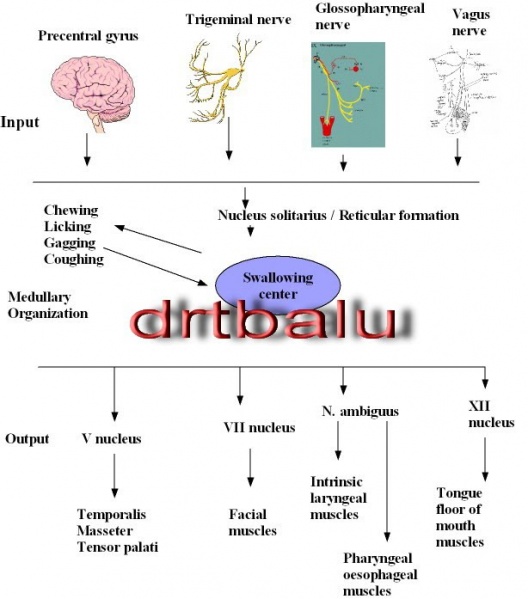Stages of Deglutition
The process of swallowing is known as deglutition. The act of swallowing can be divided into three stages for easy understanding.
1. Oral stage: This is the only voluntary stage in the act of swallowing. It consists of: Mastication of food making it into a bolus fit to be swallowed. The main muscles involved in the act of chewing are:
a. Masseter
b. Temporalis
c. Pterygoids
These muscles of mastication are supplied by the mandibular division of the trigeminal nerve. The tongue plays a vital role in this phase and is supplied by the hypoglossal nerve. The facial nerve also plays a vital role by supplying the Buccinator and orbicularis oris. These muscles prevent drooling of food from the mouth and keeps the contents inside the oral cavity by their contraction. In patients with facial palsy the buccinator and orbicularis oris are paralyzed causing drooling on that side of the mouth.
2. Pharyngeal stage: Is involuntary and is very complex. It passes the masticated food through the oropharynx, through the cricopharynx into the upper oesophagus. This passage is facilitated by relaxation of cricopharyngeus muscle.
During this phase the nasopharynx is shut off from the oropharynx by the contraction of muscles of soft palate and posterior pharyngeal wall, thus preventing nasal regurgitation of masticated food. During this phase the laryngeal musculature should also constrict to prevent aspiration. This stage relies on the coordination of many muscle groups including the muscles of the soft palate which is supplied by the 5th, 7th, 9th and 12th cranial nerves.
The pharyngeal muscles also play a vital role in propelling the food through the cricopharynx. These muscles are supplied by the 9th and 10th cranial nerves. The cricopharyngeus muscle is supplied by the 10th cranial nerve and sympathetic nerves.
Neurological disorders affecting the pharynx impair swallowing by altering motor and / or sensory functions in the oral and pharyngeal stages.
3. Oesophageal stage: This stage is again involuntary. It propels the food bolus down the oesophagus. This phase is mediated by the 10th and sympathetic nerves. This phase is dependent on the peristalsis of the oesophageal musculature. During swallowing, peristaltic waves pass down the oesophagus with waves of positive pressure reaching (50-100mmHg). When liquids and semisolids are swallowed, there is an initial negative wave caused by elevation of the larynx drawing on the cervical oesophagus. This is followed by a abrupt positive wave, which coincides with the entry of the bolus into the oesophagus. This wave is known as the primary peristaltic wave. This wave is followed by a smaller positive wave known as the stripping wave, which clears the left over food material from the oesophagus. Secondary peristaltic waves are generated in the oesophagus in response to dilatation of oesophagus Tertiary peristaltic waves are irregular, non propulsive contractions involving large segments of oesophagus. This occurs during emotional stress. When fluid is swallowed, it may be projected from the pharynx to the oesophago gastric junction in about 1 second flat (when the subject is standing). This occurs well ahead of the peristaltic wave. Thus it should be borne in mind that this fact causes burns due to swallowing of corrosive fluids more at the distal end of oesophagus.
The rate of progression of peristaltic wave varies in different portions of oesophagus:
1. In the upper part of oesophagus the peristaltic wave progresses rapidly.
2. The waves are more sluggish in the lower third of oesophagus.
These differences are due to the fact that the musculature is striated in the upper portion of oesophagus and smooth at the lower 1/3 of oesophagus.
